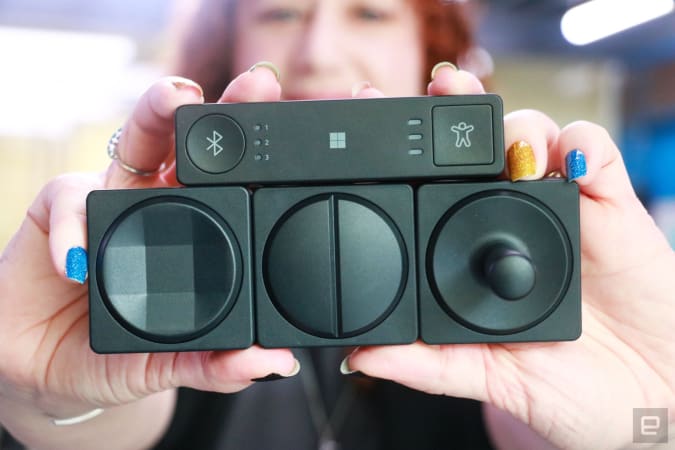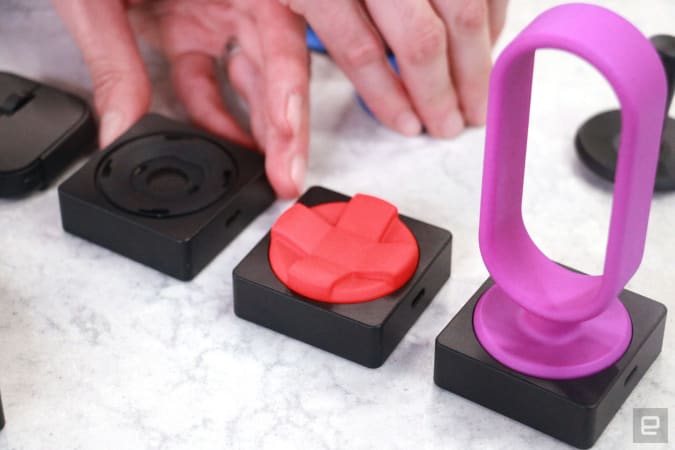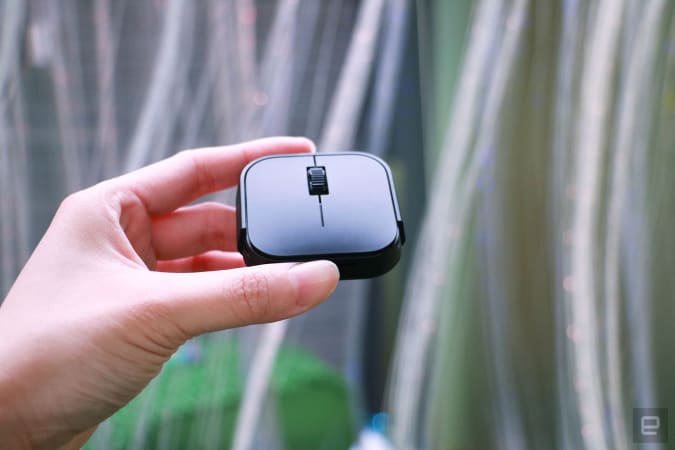They Xbox Adaptive Controllers was Microsoft’s first real attempt at making accessible hardware. And while it was very well received, it didn’t really impact non-gamers. Today, the company is launching a new product with a much wider audience: a mouse. The Microsoft Adaptive Mouse kit actually consists of a mouse, attachable tail, hub and button. They’re modular and highly customizable, offering a wide variety of ways for people with different needs to interact with their laptops, tablets or phones.
At the heart of the new Adaptive Mouse kit is, well, the mouse. Because you can insert this into different attachments, it’s sometimes referred to as the core. It’s a tiny square, approximately two inches (50mm) wide, and about as thick as my finger. There’s a scroll wheel between the left and right buttons, and on the underside you’ll find an optical sensor and triggers for Bluetooth and ejecting the back bumper.
I’ll get to the removable piece in a bit but at this point in the demo I was already enamored with the mouse, which I found really easy to use. As someone who suffers from shoulder and neck pain due to a home office setup that’s not ergonomically ideal, I loved the idea of a low-profile mouse that I didn’t have to strain to use.
At the conference table in Microsoft’s new Inclusive TechLab, I placed the mouse under my palm and dragged it around. Since it’s so small, I could move it more easily than a traditional mouse by pushing it with my fingers, instead of using my upper arm or forearm. Being able to lay my fingers mostly flat also felt less strenuous on my nerves. I barely had to lift a finger to use it.
Gallery: Microsoft Adaptive Mouse hands-on | 15 photos
Gallery: Microsoft Adaptive Mouse hands-on | 15 photos
Of course, I’m not a professionally trained ergonomist, and there are other issues like elbow angle and table height to take into consideration. I’ll also need to spend more time using the Adaptive mouse to see its long term effects. But the best part about the new kit isn’t the shape of the core, it’s that you can easily customize it to suit your needs.
The second part of the Adaptive Mouse kit is the tail. You can insert the core to this piece, after removing the bumper, and get a larger, more traditional-looking mouse with a curved shape. There’s not much to explain here, except the fact that the thumb support on the bottom is reversible for left-handed or right-handed use.
This is important. You won’t have to go and buy a separate device if you’re left-handed, which would create an othering experience that often happens with assistive tech.
The Adaptive kit becomes a lot more useful with the Hub and Button. The hub is a rectangular block that’s basically a dock with ports and buttons on it. Along the back are five 3.5mm jacks, while three USB-C ports sit in front, next to a sync button. On the top are a round Bluetooth key and a square button for toggling through up to three profiles. These are shaped differently for easy recognition by touch, and don’t require much force to press.
Cherlynn Low / Engadget
The Hub serves as a bridge between various assistive tech switches, and devices like your laptop and phone. Your PC, tablet or phone will recognize these input methods as it would a typical mouse or keyboard.
Possibly the most intriguing component of the Adaptive Mouse kit is the new Button, which you’ll also need to connect to your device via the Hub. Like the core, it’s a 50mm square, but it has eight buttons laid out in a circle. Using a PC, you can program these to perform any task you want. There’s a wide variety of possibilities here: You can map them to scroll up or down, open apps, or enter keyboard shortcuts.
The button can also handle sequential tasks, so you can have the first push open an app, then have the second tap of the same button enter a phrase, and a third send an email, for example.
At the demo, director of accessible accessories Gabi Michel showed me how to record a sequence of actions. We decided that the macro I wanted to program is to enter the words “I agree to the embargo, please share more” and hit send. In the (non-final) Windows software, Michel started a new macro, named it “Embargo agreement” and chose to record an action. She entered the sentence, inserted a pause (which tells the system to wait for a subsequent button push), then hit the Control and Enter keys on her keyboard, which would send the email in Outlook.
Cherlynn Low / Engadget
Some of the commands you can program require the relevant app to be open first, so in this case I’d have to be on Outlook before starting the macro. You can also set things like Alt-Tab or more complicated Adobe keyboard shortcuts that require several buttons to be pressed at once. As someone who frequently uses Photoshop’s Ctrl-Alt-Shift-S shortcut to save images for the web, I can already see the benefits of mapping this combination to one key.
The beauty of the Adaptive Button, though, lies in its customizability. You can twist off the wheel on the top surface and replace it with a joystick or a setup with two semicircles, which Microsoft calls a dual button. With these, people who have limited mobility can hit bigger targets to trigger their macros. The joystick, for example, can be pushed with an elbow or a head, and the eight buttons underneath can be programmed accordingly.
With the dual button, for instance, the top four inputs can be mapped to one action, while the bottom four can perform another. This is how lead industrial designer for the Adaptive accessories John Helmes has a button set up for his daughter, who has cerebral palsy. For her, pushing the top and bottom halves trigger up and down scrolling, which is helpful since she doesn’t have the dexterity for a scroll wheel.
The d-pad, dual button and joystick are toppers that Microsoft will offer at launch, but it’s teamed up with 3D printing service Shapeways to give people additional options. At the demo, I saw various designs, including one that looked like a Dyson bladeless fan.
Cherlynn Low / Engadget
The 3D-printed pieces don’t just work with the button — you can create them for the mouse core, too. Hermes said his daughter, who has involuntary movements and light spasms in her hands, uses one with deeper finger grooves on it and a stiffer, grippier texture. This helps to keep her fingers on the buttons.
Michel also showed me some other pieces, like an extended palm rest for the core, covers for scroll wheels and tails with higher arches. Whatever shape might suit you better, it seems as if there is a way to 3D print an attachment that would make the mouse easier to use.
Microsoft may have created its new Adaptive Mouse kit with the disability community in mind, but as is often the case with inclusive design, products that are made to solve problems for a small community can have benefits for a larger population. The button can make interacting with a phone or laptop easier for people with limited mobility, but it can also simplify the workflow for so many others. Video editors could map common actions to specific buttons, for example, while I would love to actually have a one-button embargo agreement shortcut.
Cherlynn Low / Engadget
I applaud Microsoft’s thoughtfulness here, but I still have lingering questions. The Adaptive Mouse, Hub and Button will be available in this case, but many details – including price – are still unclear. Too often, assistive technology is prohibitively priced, and it would be disappointing if Microsoft charged too much of a premium. With the Xbox Adaptive Controller, which launched for $99, it’s more expensive than the Xbox Wireless Controller ($50-$60) but notably cheaper than the premium Elite Controller ($170).
Without knowing the exact price of the Adaptive Mouse kit and the 3D printed pieces, it’s hard to tell how much of an impact it will have. But I do think Microsoft’s continued development of products for people with disabilities is laudable, and will hopefully trace the rest of the industry. Because fostering more competition and driving prices down will benefit not only the disability community but all of us as well.
Update (at 12:29pm ET): This article previously misstated that the Hub would support Braille display input. It won’t — assistive tech switches that would draw power from the hub aren’t supported. This story has been corrected to remove that reference.
All products recommended by Engadget are selected by our editorial team, independent of our parent company. Some of our stories include affiliate links. If you buy something through one of these links, we may earn an affiliate commission.



